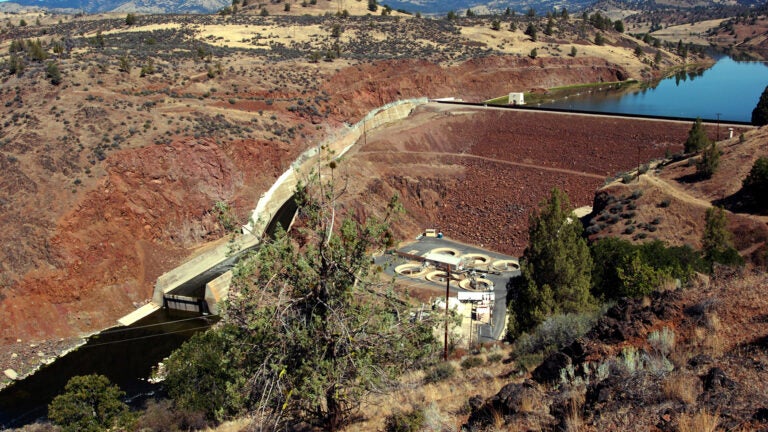
The Iron Gate Dam on the Klamath River outside Hornbrook in northern California — one that will be removed — is seen in this 2009 photo. (Photo/Jeff Barnard, The Associated Press)
Klamath Basin restoration: A new era for an ancient river
The largest river restoration and dam removal project in U.S. history is underway along the Klamath River, which runs through Oregon and California. USC experts discuss how climate change has contributed tensions to what in the past would’ve been a clear-cut environmental victory.
 The largest river restoration project in U.S. history is underway along the Klamath River, but climate change continues to raise new challenges for water management in the region.
The largest river restoration project in U.S. history is underway along the Klamath River, but climate change continues to raise new challenges for water management in the region.
Four aging hydroelectric dams along the river’s Lower Basin are scheduled to be decommissioned by 2024, with the smallest dam already demolished and the others soon to follow. The project aims to restore the river to its natural, free-flowing state and unlock over 400 miles of essential spawning habitats for local wildlife, including several species of endangered salmon.
The $500 million project comes after decades of litigation involving local tribes, communities, farmers, government agencies and energy companies — all of whom depend on the river and its resources. But experts say that years of climate-induced drought have magnified tensions over water scarcity in the Klamath Basin and much of the American West, making less water available for everyone despite the river’s undamming and dramatically reducing wetland habitats for local wildlife.
“In dry years, there hasn’t been enough water for everything: the salmon, the tribes, the ranchers and the farmers,” said water law expert Robin Craig, the Robert C. Packard Trustee Chair in Law at the USC Gould School of Law. “You can’t have agriculture and ranching without a reliable water supply because it’s too dry. But you also can’t have the fish with the dams that help make the water supply reliable. There’s tension there that is hard to escape.”
River restoration: Climate change, dams pose a double threat to the Klamath
Most rivers flow from high elevations, such as mountain ranges, down to lower ones before emptying out into the sea. Not the Klamath.
The “upside down river,” as it is known, spans 263 miles and ranks among the largest watersheds in the American West. But instead of originating in mountains, its headwaters are in the arid deserts of Eastern Oregon, where it pools into large lakes and flows slowly over flat terrain before crossing the border into Northwern California. From there, the river grows wilder as it traverses rugged mountains and dense temperate forests before finally spilling out into the Pacific Ocean.
(Story continues below map)

This peculiar geography, coupled with more than a century of human intervention through the construction of dams that disrupt the river’s natural flow, has rendered this region particularly vulnerable to a multitude of challenges now amplified by climate change, according to experts.
“For a long time, we’ve tried to control rivers to alleviate flooding, ensure access to water supply, and in the case of the Klamath dams, to provide electricity,” said Mitul Luhar, the Henry Salvatori Early Career Chair and associate professor of aerospace and mechanical engineering and civil and environmental engineering at the USC Viterbi School of Engineering. “When we dam up rivers, we substantially alter natural processes, both in terms of the flow of water and the flow of sediment which help maintain the landscape and have significant impacts on water quality.”
The federal government authorized construction of the Klamath Project in 1905 to bring irrigation water, hydroelectric dams, and storage reservoirs to the mostly arid Upper Basin and draw white settlers to the region. Wetlands that supported millions of fish and migratory waterbirds for centuries were drained to grow crops. The U.S. Bureau of Reclamation continues to manage the Klamath Project and its extensive canals that service approximately 240,000 acres of cropland, primarily concentrated in south-central Oregon.
Reduced water flow from the dams and agricultural runoff, combined with brutal heat waves and rising water temperatures brought on by climate change, have created ideal conditions in the river’s Upper Basin for toxic algae blooms to thrive. Luhar said the blooms travel far and fast, harming wildlife and posing a threat to public health as they move downstream.
“When we dam up rivers, we substantially alter natural processes.”
— Mitul Luhar, USC Viterbi
In 2002, a combination of warm temperatures, low flows and fish bottlenecking caused a bacterial outbreak that killed more than 34,000 salmon, according to the California State Water Resources Control Board, with some counts suggesting the toll may have exceeded 70,000. The massive die-off — one of the worst ever recorded in the American West — spurred local tribes to advocate for the removal of the dams.
A battle over water rights
Experts highlight that the declining salmon population in the Klamath River has intensified age-old disputes over water rights, which climate change and water scarcity have only made harder to resolve.
For over 100 years, the river has been at the center of conflict between competing interests in the river, including tribes, businesses and farmers with different levels of water rights seniority.
Since the early 1990s, federal mandates to revive populations of fish protected by the Endangered Species Act have resulted in water allocation cuts among Klamath Project stakeholders, sparking major legal battles over water rights, experts said.
Extreme drought in 2001 prompted the U.S. Bureau of Reclamation to cut water allocations for Klamath Project irrigators and conserve remaining supplies in Upper Klamath Lake to protect habitats of endangered suckerfish. Farmers and ranchers united in protest and were granted increased water allotments the following year, which ultimately contributed to the massive fish die-off in 2002, experts said.
Once the third-largest salmon run on the West Coast before it was dammed, the Klamath River and its fish have long been integral to the cultural and spiritual identity of Native American tribes in the region. For millennia, tribes such as the Yurok, Karuk, Hoopa, Shasta and Klamath carefully nurtured the environment and relied on its bounty for sustenance. The river holds personhood status under Yurok tribal law, which entitles it to the same legal rights as humans, Craig said.
Despite the tribes’ long-standing presence in the Klamath River Basin, which should technically grant them senior water rights under Western water law, U.S. courts for many years awarded senior water rights to the area’s white farmers and ranchers, Craig said.
The West’s “Law of the River” — the collection of legal documents governing American rivers’ water apportionments — gives the highest priority to whoever first accessed the water and put it to beneficial use, a principle colloquially referred to as “first in time, first in right.” While the Tribes have always possessed senior water rights through the Winters Doctrine, a legal principle established by the U.S. Supreme Court in the case of Winters v. United States in 1908, as well as other rights, Craig emphasized that it took a long time for the law to actually allow the Klamath Tribes to operationalize them.
“The Klamath is a tribal river, and it is often described that way. Until the Klamath tribes finally got their water rights recognized and quantified in court, they lost out,” Craig said. “In 1983, when the courts ultimately ruled in favor of the tribes, their water rights were determined to be extensive, dating back to time immemorial. This decision effectively placed the Klamath Tribes in a position of authority over the water within the Klamath River, at least in Oregon.”
Water rights disputes were one of several factors that led to a 2016 agreement among various stakeholders, including government agencies, Tribes, and the states of Oregon and California. This agreement aimed to manage water resources in the Klamath Basin by removing four dams – J.C. Boyle, Copco No. 1, Copco No. 2, and Iron Gate – from the Lower Klamath River. Facing the expiration of a 50-year Federal Energy Regulatory Commission (FERC) license and the prospect of a rigorous environmental review, PacifiCorp, the company that owned and operated the dams, chose the cost-effective route of surrendering the license and decommissioning the aging dams, which experts explained had always been marginally profitable and generated minimal hydroelectric power.
While the dam removal project promises to restore the river to its historic health and abundance, experts note that outcomes for the region’s stakeholders will be mixed.
Shon Hiatt, an associate professor of management and organization and director of the recently launched Business of Energy Transition Initiative at the USC Marshall School of Business, predicts that removing the Klamath River dams will reduce property values and tax revenue for counties as property owners with land next to the reservoirs lose their riverfront property.
While the restoration project raises hopes for salmon, experts warn that water woes in the American West will remain.
The increasingly severe effects of climate change are raising concerns among various stakeholders in the Klamath River Basin. Climate-induced drought is exacerbating water scarcity for everyone along the Klamath River, especially in California, where outdated and limited infrastructure makes it difficult to capture influxes of water from rivers and rain. Experts note that California hasn’t built water storage infrastructure since the 1970s, so despite last year’s record rainfall, the state is still facing a water crisis.
“As the challenge of meeting our state’s water demands looms large, the need for efficient water storage in reservoirs and its transportation to populous urban areas and productive agricultural regions is urgent. The central question at hand, however, is where to locate these vital infrastructure projects,” he said.
But experts emphasize that the river renewal and dam removal project is still a major victory for the conservation movement, which has long fought to protect free-flowing rivers and wildlife. For the first time, many of the facilities that conservationists have wanted to see removed from rivers are being taken down all at once, Hiatt said.
“If you think about it,” Craig said, “this will be the first time in over a century that salmon will be able to make it up to the Upper Klamath River. And that will be a wonderful sight to see.”
Featured Experts
Robin Craig
Expert in Ocean and coastal law, Climate change adaptation, Water law, Water rights, Water pollution, Clean Water Act, Adaptive governance and Toxic torts
Shon Hiatt
Expert in Energy sector, Biofuels, Biodiesel, Hydropower, Geothermal, Electricity sector, Oil and gas production, Business strategy, Food industry, Food production, Agribusiness, Water use, Fast Food, Restaurant business, Genetically modified foods and GMO
Mitul Luhar
Expert in Fluid Mechanics, Aerodynamics, Hydrodynamics, Soft Robotics, Turbulence, Coastal Engineering, Seagrass Beds, Kelp Forests and Drag Reduction



